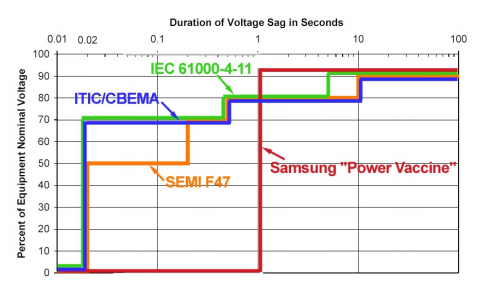"Power Vaccine" Standard
Samsung Semiconductor has developed a "Power
Vaccine" specification for semiconductor manufacturing
equipment, which is far more stringent than the usual
power quality immunity specification for this type of
equipment, SEMI F47.
What The Samsung "Power Vaccine" Specification Requires
The Samsung "Power Vaccine" specification requires semiconductor manufacturing equipment to tolerate a complete loss of power for 1 second. It indicates that a UPS should not be used to meet this requirement, and treats this requirement as a special case of IEC 61000-4- 11 (a voltage dip and interruption immunity standard that recommends some specific test levels, but permits users to select their own special cases for test levels).There has been some speculation that the 1-second requirement was actually a Korean-to-English translation error, and that what was intended was actually a much more reasonable 1-cycle requirement. However, this is probably an incorrect speculation. E-mail communication between the author of this paper and WangKeun Kim of Samsung indicates that this specification was originally written in English (using a word processor that is not generally supported in the West, which explains why only paper and FAX copies of the standard are circulated).
The specification is marked "Samsung Proprietary"

Figure 1: Depth-duration curve for voltage sag immunity - various standards. Equipment is expected to operate properly for any voltage sag with a depth-duration pair that lies above the curve. Note that the IEC, ITIC, and SEMI curves are similar to each other. The Samsung curve is much more severe; it is also applied to all three phases simultaneously, as opposed to one phase at a time for the other standards.
What Makes The Samsung Specification Different?
The Samsung specification should be compared to the SEMI F47 specification and the IEC 61000-4-11 specification.The Samsung specification calls for a complete power interruption, on all phases at the same time.
SEMI F47 is less stringent. It requires the tool to tolerate voltage sags to 50% for 200 milliseconds, 70% for 500 milliseconds, and 80% for 1 second, but only on one phase (or pair of phases) at a time. SEMI F47 recommends, but does not require, tolerating a complete power interruption for 1 cycle. SEMI F47 has a detailed test procedure, SEMI F42, while the Samsung specification makes a brief reference to IEC 61000-4-11, presumably including its test procedures.
IEC 61000-4-11 is also less stringent than the Samsung specification.
Although it does not actually specify voltage dip levels, it can be read as requiring a dip to 40% for 200 milliseconds, 70% for 500 milliseconds, and 80% for 5 seconds. It also can be read to require a complete interruption for 1 cycle. It leaves open the possibility for users to specify their own levels and durations, which Samsung has done. It is worth noting that 61000-4-11 only applies to equipment which draws less than 16 amps per phase. We are still drafting the corresponding standard, 61000-4-34, that applies to equipment that draws more current.
Complying with the Specification
Different manufacturers of semiconductor tools have taken different approaches to Samsung's specification.Although the Samsung "Power Vaccine" specification is more stringent than most power quality immunity standards, there are several approaches that can satisfy the requirements, including one approach that is almost free. Taking this last approach also guarantees compliance with SEMI F47 and IEC 61000-4-11 as well.




















